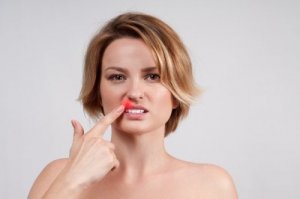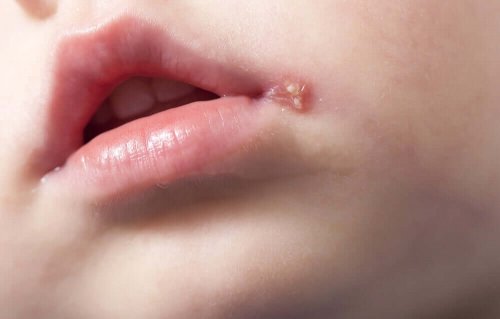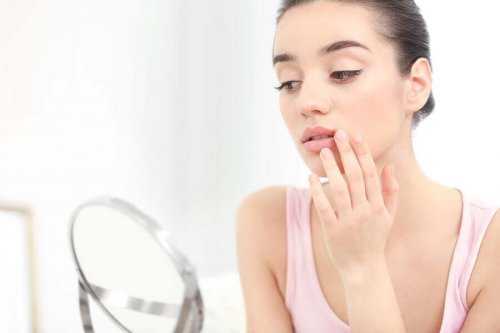Cold Sore Characteristics and Treatment

A cold sore is an infection on the lips, gums, or other parts of the mouth. The herpes simplex virus is responsible for this infection, and it manifests as one or several blisters or lesions.
Overall, there are two herpes strains:
- HSV-1, the virus that leads to cold sores
- HSV-2, the virus that causes genital herpes
Between 20% and 40% of adults are affected at some point, according to information in BMJ Clinical Evidence. However, most primary infections usually happen during childhood and scientists believe that the virus remains dormant in the trigeminal ganglion.
Why do we get a cold sore?
This virus stays in the body. Therefore, after overcoming the symptoms of the first infection, it produces symptoms again when something triggers it.
Also, this virus easily spreads on contact when there are lesions. Thus, the use of objects that may have been in contact with a lesion, such as razor blades, towels, lipstick, is a no-no.
According to the WHO, there are about 3.7 billion people under the age of 50 infected by this type of herpes worldwide. However, it’s important to remember that this isn’t a genetic condition.

Risk Factors
Certain factors can facilitate the appearance of this virus. For example:
- A depressed immune system
- Autoimmune diseases such as HIV/AIDS
- Severe burns
- Chemotherapy treatments
- Drug treatment to prevent a transplant rejection
You may be interested in Vaginal Herpes – What is It and How to Prevent It
Symptoms of a cold sore
Cold sores can be mild or severe, and some people may even be asymptomatic. Typically, the first symptoms appear about 1-2 weeks after infection and usually last about 7 to 15 days.
The most common symptoms are:
- Itching in the area of the lesion
- A burning sensation
- The appearance of blisters (these usually appear around the lips)
- Tingling in the area near the lips (usually before the blisters manifest)
- Swollen lips
- Oozing and crusting
- Throat discomfort or swollen lymph nodes

Why do they occur?
There are many possible reasons why these infections occur. Also, subsequent infections may occur after the first incidence of this viral infection. Typically, cold sore infections are due to:
- Lowered defenses
- Stress
- Excessive sunbathing
- Menstruation
- Hormonal changes
- Fever
Tests to detect a cold sore
A doctor will do various tests when herpes outbursts become recurrent or when the lesions are larger than normal. However, the most common one is a viral culture of blisters during their early stage.
Don’t miss: Herpes Simplex Viruses and Their Characteristics
Treatment
There are two types of treatment for this pathology:
- Topical treatment. This consists of applying an antiviral lotion directly to the area. Overall, this treatment is effective when applied at the first signs of discomfort.
- Medication. Sometimes, it’s necessary to treat it at a systemic level. Then, doctors prescribe the same kinds of antivirals but orally, in tablet form. The drugs most commonly prescribed are Acyclovi, Famciclovir, and Valacyclovir.
Physicians also prescribe treatments such as analgesics to help with the discomfort. However, there are other tips to improve or avoid cold sores besides drugs:
- First, don’t share utensils with people who might have them.
- Use lip balm to keep them from drying out.
- Eat a healthy diet.
- Finally, don’t kiss others when you have a cold sore.
Conclusion
Overall, herpes labialis is a highly contagious infection that’s caused by the herpes simplex virus. Also, even though the first infection usually occurs during childhood, it can come back in adulthood due to a variety of factors. Therefore, you’ll need antivirals to keep it at bay.
All cited sources were thoroughly reviewed by our team to ensure their quality, reliability, currency, and validity. The bibliography of this article was considered reliable and of academic or scientific accuracy.
- Chi, C. C., Wang, S. H., Delamere, F. M., Wojnarowska, F., Peters, M. C., & Kanjirath, P. P. (2015, August 7). Interventions for prevention of herpes simplex labialis (cold sores on the lips). Cochrane Database of Systematic Reviews. John Wiley and Sons Ltd. https://doi.org/10.1002/14651858.CD010095.pub2
- Cunningham, A., Griffiths, P., Leone, P., Mindel, A., Patel, R., Stanberry, L., & Whitley, R. (2012, January). Current management and recommendations for access to antiviral therapy of herpes labialis. Journal of Clinical Virology. https://doi.org/10.1016/j.jcv.2011.08.003
- Fatahzadeh, M., & Schwartz, R. A. (2007, November). Human herpes simplex labialis. Clinical and Experimental Dermatology. https://doi.org/10.1111/j.1365-2230.2007.02473.x
- Larissa Hirsch, MD. (2019). Herpes labial (VHS-1). The Nemours Foundation. https://kidshealth.org/es/teens/cold-sores-esp.html
- Opstelten, W., Neven, A. K., & Eekhof, J. (2008, December). Treatment and prevention of herpes labialis. Canadian Family Physician.
- Worrall, G. (2006). Herpes labialis. BMJ Clinical Evidence. https://doi.org/10.1056/NEJMicm063204
This text is provided for informational purposes only and does not replace consultation with a professional. If in doubt, consult your specialist.








